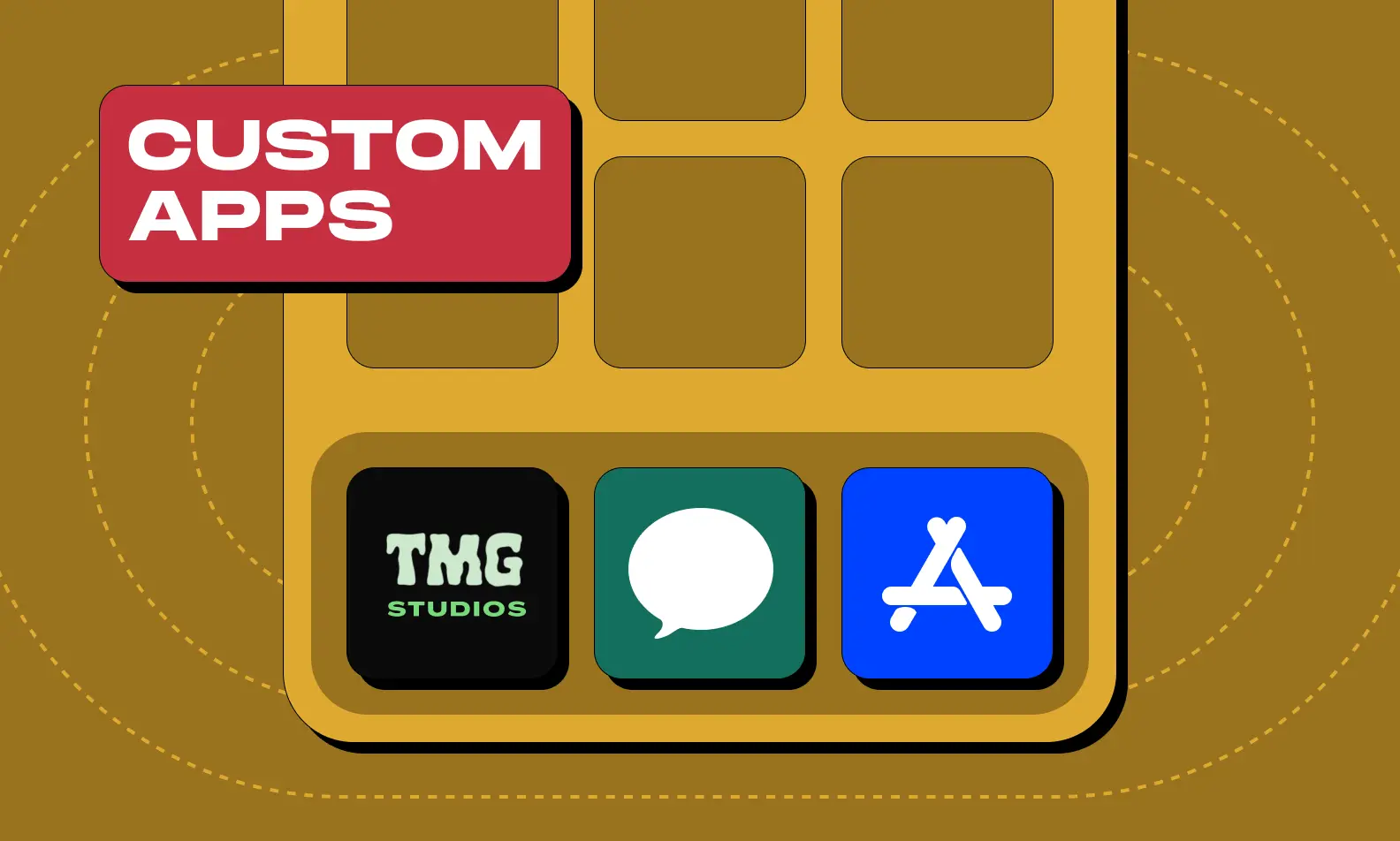How to Create Your Own Custom App: 7 Steps for Creators

Do you want to create a custom app? Well, you’ve come to the right place!
In recent years, custom apps have become essential tools for creators who want to streamline their content and distinguish themselves in a crowded digital marketplace.
Whether you're looking to enhance your e-commerce business, create an internal communication tool, or want to design a mobile game, custom apps offer unparalleled benefits for creators looking to provide their consumers with a unique and personalized experience.
In this article, we’ll guide you through the intricate process of developing your own custom app. From defining your idea and conducting thorough market research to designing, prototyping, and developing your app, we've got you covered with all the key stages you need to succeed.
What Is A Custom App?
A custom app is bespoke software meticulously designed to address the specific needs of a client or organization. Unlike off-the-shelf solutions, custom apps are tailored to tackle unique challenges and seize specific opportunities.
For businesses and creators, these applications serve as versatile tools for content creation and distribution. Whether it's delivering multimedia content via mobile apps or managing editorial calendars on web platforms, custom apps empower the creator to realize their vision without compromise.
In addition, these apps can also incorporate various monetization strategies, including subscriptions and membership, in-app purchases, and ad integrations, opening up new and exciting revenue opportunities for creators.
However, despite their numerous advantages, mobile app development requires a high level of expertise in development and ongoing maintenance to ensure they remain secure, functional, and aligned with evolving business needs.
In the following sections, we will explore each step of this process in detail, providing content creators with the knowledge and tools necessary to effectively navigate the transformative potential of custom app development.
Benefits Of Custom Apps
Custom apps offer a plethora of advantages for content creators, empowering them to optimize their workflows, enhance user experiences, and elevate their brand presence in the digital realm. Here are six key benefits of developing custom apps:
Ease of Use
One of the primary benefits of custom apps is their intuitive and user-friendly interface.
Unlike off-the-shelf software solutions that may contain extraneous features or complex navigation menus, custom apps are designed with the end user in mind.
By prioritizing simplicity and clarity in design, custom apps ensure that users can easily navigate the application and access the features they need without unnecessary hassle or confusion.
This ease of use not only enhances user satisfaction but also increases productivity and engagement.
Ease of Customization
Custom apps are uniquely crafted to cater to the specific requirements and preferences of their intended users, offering a high degree of customization that generic apps cannot match.
This customization enables content creators to seamlessly integrate features, branding elements, and functionalities that precisely align with their strategic goals and objectives.
For example, they can incorporate custom themes that reflect their brand identity, embed personalized content recommendations to enhance user engagement or implement proprietary algorithms to provide unique value propositions.
This tailored approach not only enhances user satisfaction by delivering a personalized and relevant experience but also fosters long-term loyalty by consistently meeting and exceeding user expectations.
Integrations
You can seamlessly integrate your custom app with other tools, platforms, and systems, enabling content creators to leverage existing infrastructure and maximize efficiency.
Whether it's integrating with social media platforms for seamless sharing and promotion, connecting with analytics tools for data-driven insights, or interfacing with e-commerce platforms for seamless transactions, custom apps facilitate a cohesive and interconnected digital ecosystem.
By eliminating silos and streamlining workflows, integrations enhance productivity, collaboration, and scalability.
Efficiency
Custom apps are designed to optimize workflows, automate repetitive tasks, and eliminate inefficiencies, enabling content creators to work smarter, not harder.
By centralizing essential tools and resources within a single application, custom apps reduce the need to switch between disparate systems, saving time and minimizing distractions.
Additionally, mobile applications can incorporate workflow automation features such as task scheduling, notifications, and approval workflows, further enhancing efficiency and productivity.
This streamlined approach allows content creators to focus their time and energy on creating compelling content rather than getting bogged down by administrative tasks.
Improved User Experience
User experience (UX) is paramount in the digital landscape, and custom apps excel in delivering exceptional user experiences tailored to the preferences and behaviors of the target audience.
Through thoughtful user research, iterative design, and usability testing, custom apps prioritize usability, accessibility, and satisfaction. From seamless onboarding experiences to intuitive navigation flows and responsive design, every aspect of the user journey is carefully crafted to delight and engage users.
By prioritizing user experience, custom apps can foster deeper connections with audiences, driving retention, loyalty, and advocacy.
Increased Brand Recognition and Engagement
Custom apps provide content creators with a powerful platform to showcase their brand identity, values, and unique selling propositions.
Through custom branding, messaging, and visuals, custom apps reinforce brand recognition and resonance, establishing a memorable and distinctive presence in the minds of users.
Additionally, custom apps offer opportunities for interactive engagement, personalized content delivery, and community building, fostering deeper connections between creators and their audiences.
How To Build Custom Apps In 7 Steps
Creating custom apps requires careful planning, strategic decision-making, and meticulous execution. Here's a comprehensive guide outlining the key steps involved in building custom apps:
1. Define Your Idea
Before embarking on app development, it is crucial to define your idea with precision and clarity. This involves articulating your core objectives, identifying your target audience, and specifying the desired outcomes for the app.
Begin by pinpointing the particular needs and challenges that your app will address—whether these are user pain points, gaps in the current market, or process inefficiencies.
Clearly outline the goals you aim to achieve, such as improving operational efficiency, enhancing user experiences, expanding customer engagement, or generating new revenue streams. This foundational understanding will act as a guiding compass throughout the development process, ensuring that every decision made is aligned with your overall vision.
For example, if your goal is to streamline workflow for small businesses, the app's features might focus on automation, integrating with existing tools, or user-friendly interfaces.
On the other hand, if the objective is to create a social platform, your emphasis might be placed on community features, content sharing, and real-time communication.
By establishing a clear definition of your app idea, you set the stage for a focused and successful development journey, maximizing the potential for your app to meet the needs and exceed the expectations of your intended users.
2. Do Your Research
Conducting thorough research is vital to the app creation process. It allows you to gain valuable insights into market trends, user preferences, and competitor offerings.
Start by performing comprehensive market research to identify existing gaps and opportunities within your chosen niche. This involves analyzing user feedback and reviews of similar apps to understand what users like, dislike, and desire in current offerings.
Additionally, studying market trends will help you anticipate shifts in user behavior and technology, enabling you to future-proof your app.
This research will guide your decision-making, ensuring that every aspect of your app's design and functionality aligns with the needs and expectations of your target audience.
By grounding yourself in solid research, you increase the likelihood of developing an app that stands out in the marketplace and resonates deeply with users.
3. Decide Your App’s Features
Determining the features and functionality of your app is a critical step that requires careful consideration of your needs, goals, and research findings.
Begin by outlining the essential features that will address the core challenges and objectives identified in the initial planning stages. Prioritize these features based on their significance to your target audience and their feasibility within your budget and timeline constraints.
Key features might include user authentication for secure access, content delivery systems to ensure users receive relevant information, and social sharing capabilities to foster user engagement and virality.
Additionally, consider integrating in-app purchases to create revenue streams, push notifications to maintain user engagement, and analytics tracking to gather insights on user behavior and app performance. Each of these features can significantly enhance the app's value proposition and user experience, making it more appealing and useful to your audience.
By balancing the inclusion of high-priority features with practical constraints, you can develop a well-rounded, effective app that meets both your business objectives and user expectations.
4. Choose Your Development Path
When it comes to app development, you have several options to choose from, including native app development, cross-platform app development, and low-code/no-code app development.
Native app development entails crafting applications specifically for a single platform, leveraging its full capabilities and native features. This can lead to optimal performance and user experience but may require more time and resources for separate development for each platform.
On the other hand, cross-platform app development allows for building apps that can run on multiple platforms, potentially reducing development time and costs. However, it may sacrifice some performance optimizations and platform-specific functionalities.
Additionally, low-code/no-code app development platforms offer rapid app development through visual interfaces and pre-built components, ideal for those with limited technical expertise or tight deadlines, although they may have limitations in customization and scalability.
When choosing your developmental path, it’s important to evaluate the pros and cons of each approach based on factors such as budget, time-to-market, platform compatibility, and scalability. Remember to select the path that best aligns with your needs, resources, and technical expertise, enabling you to achieve your goals effectively and efficiently.
5. Create An App Design and Prototype
Once you've finalized your app's features and development path, it's time to design the user interface (UI) and user experience (UX), ensuring users have a seamless interaction with your application.
Collaborate closely with designers to translate your app's functionalities into visual elements by creating wireframes, mockups, and prototypes. These design artifacts serve as blueprints that outline the app's layout, navigation flow, and interaction patterns, allowing for early visualization and validation of ideas.
Make sure you prioritize usability, accessibility, and aesthetics during the design phase, striving to create an intuitive and visually appealing interface that enhances user engagement and satisfaction.
As you progress, gather feedback from stakeholders and conduct usability testing to identify pain points and areas for improvement, iterating on the design iteratively to refine and optimize the user experience.
By investing time and effort into thoughtful design and prototyping, you lay the groundwork for a successful app that resonates with your target audience and drives user adoption.
6. Initiate Development and Testing
Once the design has been finalized and approved, it's time to transition into the development phase, where the vision for your app begins to take shape.
Depending on the chosen development path—whether native, cross-platform, or low-code/no-code—developers will translate design concepts into functional code. This may involve writing code from scratch, utilizing development frameworks and libraries to expedite the process, or leveraging intuitive low-code/no-code platforms for rapid development.
It's crucial to maintain close collaboration with developers throughout this phase, providing clear guidance and feedback to ensure that the app's features are implemented accurately and efficiently. To guarantee the app's integrity and robustness, emphasize adherence to coding standards, security protocols, and performance optimization techniques.
Simultaneously, rigorous testing procedures should be conducted at every stage of development to identify and rectify any bugs, usability issues, or compatibility concerns across various devices and operating systems.
By prioritizing collaboration, adherence to best practices, and comprehensive testing, you can propel the development process forward smoothly, inching closer towards the realization of your app's full potential.
7. Maintenance Check
After you’ve successfully launched your mobile web app, it's crucial to recognize that the journey is far from over. Consistently maintaining and supporting your app is crucial in sustaining its performance and relevance.
Start by establishing comprehensive maintenance that encompasses regular updates, bug fixes, performance enhancements, and security patches. These routine updates not only ensure that your app remains secure and reliable but also allow you to incorporate new features and functionalities to stay ahead of the curve.
Utilize user feedback and analytics data to gain insights into how your app is being used and where improvements can be made. You can prioritize enhancements that align with your audience's evolving needs and preferences by continuously monitoring user satisfaction and engagement metrics.
Moreover, staying up-to-date on the latest technological advancements and industry trends enables you to adapt your app to changes in the competitive landscape, ensuring its longevity and sustained value.
By investing in ongoing maintenance and support, you not only safeguard your app's performance but also demonstrate a commitment to delivering an exceptional user experience that fosters long-term loyalty and satisfaction.
Frequently Asked Questions
How much does it cost to create an app?
The cost of creating an app can vary widely depending on factors such as the complexity of features, platform compatibility, development approach, and geographical location of the development team. Custom app development projects typically range from several thousand to several hundred thousand dollars, with costs influenced by design, development, testing, deployment, and ongoing maintenance expenses.
How do you create an app for free?
While it's possible to create basic apps for free using low-code/no-code platforms or app builders, these free tools often come with limitations in terms of functionality, customization options, and scalability. For more robust and feature-rich custom apps, expect to incur expenses for development, design, and maintenance. However, platforms like Fourthwall offer cost-effective solutions for content creators to create custom apps without the need for coding or upfront development costs.
How long does it take to create a mobile app?
The timeline for creating a mobile app can vary depending on factors such as project scope, complexity of features, development approach, and team size. Simple apps with basic features may take a few weeks to develop, while more complex apps with advanced functionality and integrations can take several months or even years to complete. It's essential to establish realistic timelines and milestones based on your project requirements and resources to ensure a successful and timely app launch.
Create A Custom App Based On Your Fourthwall Membership Site
If you're a content creator looking to create a custom app without the need for coding or app store approval, Fourthwall offers an innovative solution.
With Fourthwall's membership site platform, creators can effortlessly generate their own mobile app that is automatically branded to match their Fourthwall site.
This seamless integration allows members to access exclusive content, engage with the community, and shop for products or services directly from the app, enhancing the overall member experience and driving retention and loyalty.
Get started building your own custom app by joining Fourthwall today!
















